#The Baja Bandeeto
Explore tagged Tumblr posts
Text
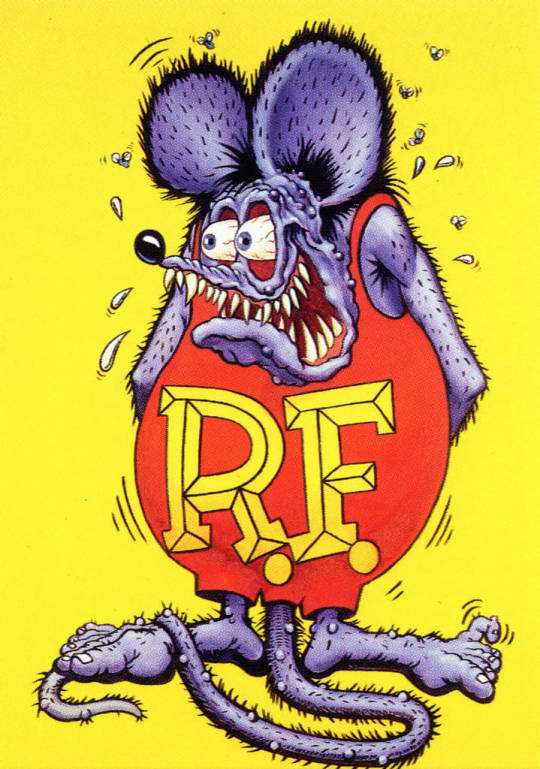

The Orbitron
The Orbitron is a custom car built by Ed Roth and feared lost until its rediscovery in Mexico in 2007
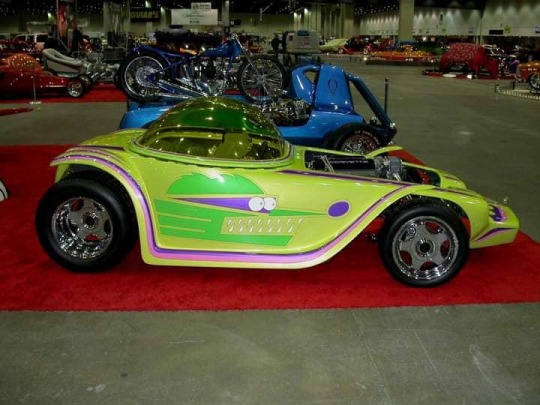
A second generation to Roth's original Beatnik Bandit, which was built in 1960, the Beatnik Bandit II features a one-of-a-kind fiberglass body with PPG lemon meringue pie paint, stylized Rat Fink designs on the sides, and chrome by Metal Masters of Salt Lake City, UT.
Beatnik Bandit II includes many unique design features, including an electronic console which operates the digital instrument panel and other features such as a digital readout of the car's latitude and longitude.
The lack of a rearview mirror is not a problem on this car. A "TV mirror" video monitor is mounted on the console with the actual camera mounted in the rear panel. The bubble top is also lifted electronically.
Beatnik Bandit II was built entirely by Roth, who credits "Revelations from Father in Heaven" for his achievement. The car has been shown in major U. S. cities, including Boston, Los Angeles, Chicago and Houston, as well as in Yokohama, Japan.

The Beatnik Bandit
Ed 'Big Daddy' Roth was an artist, cartoonist, illustrator, pinstriper and custom car designer and builder who created the hot-rod icon Rat Fink and other characters. Roth was a key figure in Southern California's Kustom Kulture and hot-rod movement of the late 1950s and 1960s The Beatnik Bandit was one of his first creations from the early 1960s. It was built from a 1949 Oldsmobile, the chassis was shortened 5 feet, the Olds engine was given the classic hotrod look with GMC blower and twin carbys, everything was chromed except the blower belt. The white interior featured single joystick, that operated turning, throttle and braking. The bubble top was created using compressed air to inflate a sheet of plastic into a dome in a pizza oven. On display at the National Automobile Museum in Reno
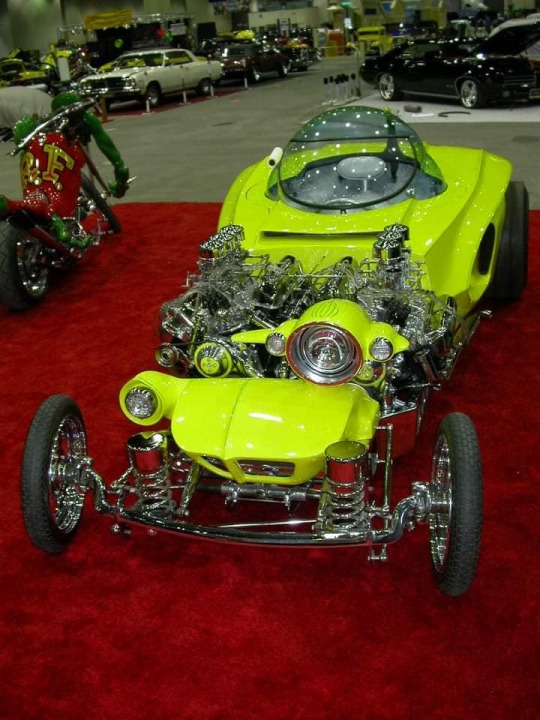
Mysterion
Ed Roth built the Mysterion in 1963, he got the idea from the multi engine dragsters he had seen at the dragstrips. He combined two Ford engines, two transmissions, plus two welded rear ends for the foundation. It featured an offset headlight and the typical Ed Roth bubble top. On display at Galpin Auto Sports.
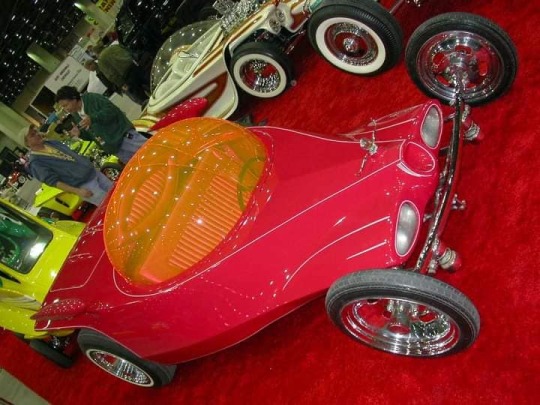
The Road Agent by Ed “Big Daddy” Roth.
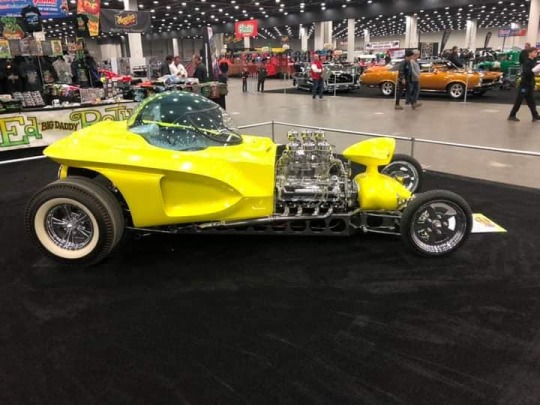
Mysterion
Custom builder and artist Ed "Big Daddy" Roth completed the Mysterion in 1963. The bubbletopped custom featured a completely original fiberglass body and twin Ford big-block engines. The weight of the engines was too much for the frame to bear, and the Mysterion fell apart. Tribute versions have been built, including this precise replica from Galpin Auto Sports.

The Surfink
The Surfink, created by Mark Glaz as a tribute to Ed Roth and Ratfink, features a large Ratfink figure atop a surfboard complete with a blown V-8 engine.
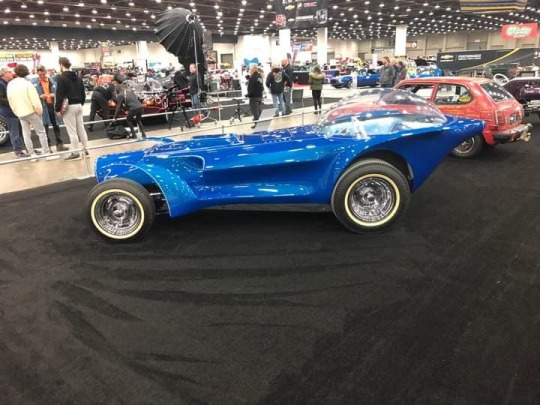
The Orbitron
Built in 1964, the vehicle was powered by a 1955 or 1956 Chevrolet V8 and was backed by a Powerglide automatic transmission. The body was hand-laid fiberglass, hiding Roth's extensive chrome work to the chassis. The cockpit, set at the extreme rear of the vehicle in the manner of a dragster, was lined with fake fur and featured an 11-inch General Electric "1-Touch" portable television inserted in the console. Topping the cockpit was a custom-made, hydraulically operated Plexiglas bubble top. One of a series of ordinary doorbell push-button switches atop the hood activated the top from the outside.
Other mechanical features included a 1956 Chevrolet rear end, dropped Ford front axle beam, Buickbrake drums and early Ford brakes. The frame was handmade of rectangular 2x4 inch steel tubing. The engine was a leftover from one of Roth's 1955 Chevrolets, having been removed to make way for a then-new Mark IV big-block given to him by General Motors. It was one of the very few completed cars Roth deemed to be a "mistake" because he felt the car did not show well since the heavily chromed engine and most of the chassis were hidden. The Orbitron was, in fact, one of his few customs to have a hood. Reportedly, the hydraulically operated hood did not fit well due to rushed fiberglass work.
The vehicle's most distinctive feature was its asymmetrical front end with red, green and blue tinted headlamps. It was thought that the three beams when combined would produce an intense white light; the idea came from the then-new medium of color television.

By Jerry Thompson - originally posted to Flickr as 2C7O4069, CC BY 2.0, https://commons.wikimedia.org/w/index.php?curid=5973582
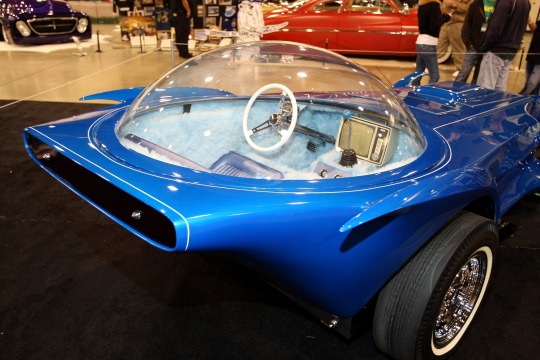
By Jerry Thompson - originally posted to Flickr as 2C7O4066, CC BY 2.0, https://commons.wikimedia.org/w/index.php?curid=5973591

The Baja Bandeeto
Custom car builder and renowned painter Fritz ‘Spritz By Fritz‘ Schenck recreated with his bubble top roadster; the Baja Bandeeto.
#The Orbitron#car#cars#Beatnik Bandit II#ed roth#rat fink#The Beatnik Bandit#Beatnik Bandit#Ed 'Big Daddy' Roth#big daddy roth#big daddy#mysterion#The Road Agent#The Surfink#Surfink#The Baja Bandeeto#Fritz Schenck
71 notes
·
View notes
Photo

Spritz by Fritz's Baja Bandeeto at the 2017 #DetroitAutorama by Dan's Hot Rod Photo - see more here: http://buff.ly/2mJegxy
33 notes
·
View notes
Text
Making the Scene: Traditional Hot Rods & Customs Steal the Show at the 2017 Detroit Autorama
Forgetting for the moment that Motown reached a record high of 70 degrees F on the opening day this year, the Detroit Autorama has been the hot rodder’s oasis amid the snow and usually bitter cold of Motown’s notorious winters for 65 years.
The Michigan Hot Rod Association (MHRA) hosted the very successful inaugural event in 1953 and quickly handed the show’s reigns to Don Ridler, a local promoter. The Autorama mushroomed over the next few years, and ticket sales supported MHRA’s quest to build Michigan’s first official, sanctioned dragstrip.
After Don Ridler’s death, a memorial award was created in his honor, and the first one was bestowed in 1964 to Al Bergler’s AA/C race car, dubbed More Aggravation. In the ensuing years, the Ridler award grew into one of the hot rodding world’s most prestigious trophies, ranking with the Grand National Roadster Show’s America’s Most Beautiful Roadster award. It is awarded only to vehicles that debut at the Detroit Autorama, which guarantees a fresh show every year, with the latest creations from industry legends and up-and-comers alike.
Anyone who’s tracked the Ridler award and the batch of finalists known as the Great 8 over the past few years knows that today’s contenders are cost-be-damned rolling sculptures. They’re gorgeous, inspiring, and flawless. They just don’t have much in common with traditional hot rods. Well, mostly.
There were a couple of surprisingly traditional entries under the bright lights this year, including Great 8 finalists Ted and Colleen Hubbard’s ’30 Ford and—not surprisingly—a Deuce Tudor from George Poteet. The Ridler award was bestowed on a ’33 Ford-based custom rod built by Steve’s Auto Restoration for Marcy and Buddy Jordan.
While the Ridler contenders represent the upper echelon of project car spending, the rest of the vehicles on display convey decidedly more down-to-earth approaches to personalization and performance. It is the quintessential blue-collar city, after all, and that’s reflected in most of the hot rods under the lights.
The Detroit Autorama is definitely a bucket list event. And for those who slog through dark, cold, and slushy winters, it’s a warm respite providing a glimpse of the warm-weather car season that’s not too far away.
By the way, MHRA got their track. The pavement was laid, the timing tower erected, and the venue, which would be called Motor City Dragway, finally opened for time trials in 1957. MHRA board member Bob Larivee was tasked with managing the strip, which was located in rural New Baltimore, northeast of Detroit. In 1959, he founded Promotions, Inc. to promote car shows, which lead to the formation of the International Show Car Association (ISCA) by 1963.
The Motor City Dragway track succumbed to suburban sprawl in 1978, but its roots were in the Autorama that continues to thrive.
Former Ridler winners Ted and Colleen Hubbard were contending again in 2017 with their neo-traditional ’30 Ford five-window dubbed Afterthought. It is a stunner, built on aftermarket, modified ’32-style framerails featuring handmade cross members and custom, scratch-machined wishbones. The blown, Ardun hemi-headed flathead adds to the car’s carefully crafted “as cast” color/appearance theme.
The A-bone artisans at West Virginia’s Hilton Hot Rods gave Ralph and Linda Miller’s ’30 Tudor their characteristically spot-on stance. The chopped body (with a ’32 firewall) rests on a ’32 Ford frame that also houses a Ross Racing Engines–built early Hemi, trimmed with a 4-71 huffer, a quartet of Ford 94-series carbs, and a Vertex mag. Sixteen-inch chromed steelies complete the period-perfect look.
Jeff Knudsen’s true barn-find ’36 Ford Club Cabriolet was found in western Michigan, and the only thing he’s done to it is lower it and add rear fender skirts. It was last repainted probably sometime in the early 1960s, and its original engine was changed to a later flathead, too. ���No more changes or updates,” Knudsen told us. “It’s done.”
John Cassiol painstakingly restored and maintains Jim Oddy’s ’48 Austin-based AA Gasser, from locating the same type of Fiat seats used originally to replicating the old Sapphire Mist paint. Power comes from a blown, gas-sipping 392 Hemi. Buffalo-based Oddy found the car on Grand Island, New York, south of Niagara Falls, quickly built a race car out of it, and became one of the East Coast’s fiercest competitors. The car makes appearances regularly at nostalgia drag events.
Don “The Egyptian” Boeke’s ’55 Lincoln Nadine is chopped, shaved, frenched … you name it. It also remains Lincoln-powered. The pearl-yellow paint job features darker fogged highlights around the edges and is complemented by yellow-and-white upholstery. The roof is a very pale yellow with intricate cobwebbing that must have taken ages and a bottomless reserve of patience to complete.
The nose-up attitude of Kevin Doolittle’s straight-axle ’29 Ford pickup D/Gas tribute is remarkable for its attention to detail and the fact that it’s Ford powered. A balanced, blueprinted, and tunnel-rammed 289 helps light off the pie-crust cheater slicks via a 3.90-geared 9-inch axle. The authentic 23-karat gold-leaf graphics were handled by Dick Briggs, while Hillside Hot Rods did the truck’s body and chassis fabrication.
Chris and Donna Schlaff’s Brookville-bodied Deuce highboy makes a big statement with understated and timeless style. The luscious black roadster complemented with red guts sports a BopTop removable convertible top that stows in the trunk. It also runs a Chevy 348 and rolls on polished, 15-inch Real Rodders “small kidney beans” wheels.
Ed Roth would be proud of how Frtiz Schenck’s Baja Bandeeto channels the whimsy of his imagination. Illustrator Jimmy Smith penned the design, and Schenck took it from there. He made and painted the one-off, hand-formed fiberglass body, with a Plexiglas canopy, which rests on a scratch-built chassis that’s home to a VW 1600 engine. The bubble-topped interior is trimmed in white “Big Foot fur,” natch.
Mark “Topes” Thompson hawks his hot rod art out of an old, home-built ’55 Pontiac Starchief-based camper. Its crap-tastic execution belies a surprisingly warm and period-appointed cabin. Check out the artist’s work by searching Topes Art on Facebook.
Designer Brook Stevens, who designed the original Oscar Mayer Weinermobile, also conceived this radically altered ’41 Chevy coupe, which was originally commissioned by an Oscar Mayer exec in 1959. Dan, Don, and Janet Tonielli are the current caretakers, after rescuing it from a barn. Look closely and you’ll the see its long nose, low-slung proportional influence in one of Stevens’ later design projects, the ’62 Studebaker Gran Turismo Hawk.
The ElDorodder ’32 Ford Tudor was a show car built in the 1950s by Bill White, who was the president of the ElDorodders car club. It wasn’t quite finished when it was shown in 1959 at Darryl Starbird’s show in Wichita, Kansas. White died later that year, and the car went into storage. Vern Gray purchased the still-unfinished hot rod in 2015 and saw it through to its natural, period conclusion. That’s a 390 Cadillac mill between the fenders.
The story on Tommy Wahl’s barn-find T-bucket is that the owner/builder passed on a long, long time ago, and the car simply sat. His widow finally decided to sell it, and Wahl caught wind of it via a Craigslist ad. It is reportedly as-built from the late 1950s, including the ’57-vintage 283 small-block.
The legendary, 89-years-young Gene Winfield held class in Detroit, demonstrating top-chopping on a ’50 Ford.
Silver Cloud was another time-worn show car at the Autorama. Originally built by Doug Mattox in Texas, the ’60 Edsel Ranger was fitted with ’64 Chrysler headlamps, layer upon layer of silver metalflake lacquer, a 331 Hemi, chromed chassis components, and a thoroughly customized, Thunderbird-based interior. The car was even featured in a 1966 edition of 1001 Custom Car Ideas.
In 1953, Chevrolet built the Corvette in Flint, Michigan, and that’s also where the Tini Home camper was built. Weighing only 1,400 pounds and stretching a mere 14.6 feet in length, it’s indeed a diminutive domicile on wheels. And forget about the original engine and trans. This thing is packing its original stove, furnace, and icebox.
With all the black and suede hot rods out there, Rudy Duperron’s ’34 Ford three-window is refreshing for its classic, flame-licked red exterior. It’s a simple yet effective presentation powered by a simple yet effective small-block Chevy.
We didn’t get too much data on Nathan Stewart’s Y-block-powered ’31 Ford coupe but liked what we saw, from the channeled body and Deuce grille to the pinstriped steelies. The louvered visor was matched with a louvered deck lid, too.
There’s a school of thought that a 6-71 blower on a flathead is aesthetically unpleasing and overkill for performance, but it’s hard to argue with the effect of this one on a prepped 8BA. It helps that the huffed flattie is nestled in a vintage ’59 Chassis Research K88 dragster.
Bill Kellogg’s ’glass-bodied Willys was built to suggest a barn-find Gasser, including coating the exterior with 3M spray tack and blowing dust onto it for a permanent patina. The engine is a blown, Isky-cammed 392 Hemi backed by a Turbo 400 that sends torque to a 4.56-geared, spool-equipped 9-inch axle.
Metal-shaping supplier Fournier Enterprises, which also hosts metalworking classes, was on hand demonstrating its products. We happened by when one of its experts took time for more personal instruction for a couple of next-generation enthusiasts. We’ll be looking for their builds in about 20 years.
Chris Evans’ sharp Blue Bayou roadster (BLUBYU reads the license plate) was an AMBR contender at the Grand National Roadster Show last year. It’s an all-steel car powered by a ’54 331 Hemi built with a mix of traditional and contemporary speed parts, like the “Strombergs” on the engine that are actually EFI throttle bodies.
The ’59 Ranchero’s long, low lines make a surprisingly strong foundation for a mild custom, especially when it’s hugging the concrete like Kyle Raetz’s. The 3-inch lowering is complemented by the contrasting color scheme that visually lengthens the Rancho. Note the ’59 Cadillac taillights, too. Under the hood is the original 292 Y-Block.
An Edelbrock aluminum intake draws fuel and air through a sextet of Holley/Ford 94-series carbs to feed the small-block Chevy powering Patrick Hampton’s ’30 Model A.
The post Making the Scene: Traditional Hot Rods & Customs Steal the Show at the 2017 Detroit Autorama appeared first on Hot Rod Network.
from Hot Rod Network http://www.hotrod.com/articles/making-scene-traditional-hot-rods-customs-steal-show-2017-detroit-autorama/ via IFTTT
0 notes
Photo

Spritz by Fritz's Baja Bandeeto at the 2017 #StarbirdRodAndCustomShow Brought To You By #CrownCustom - http://buff.ly/2m6rxQB
10 notes
·
View notes